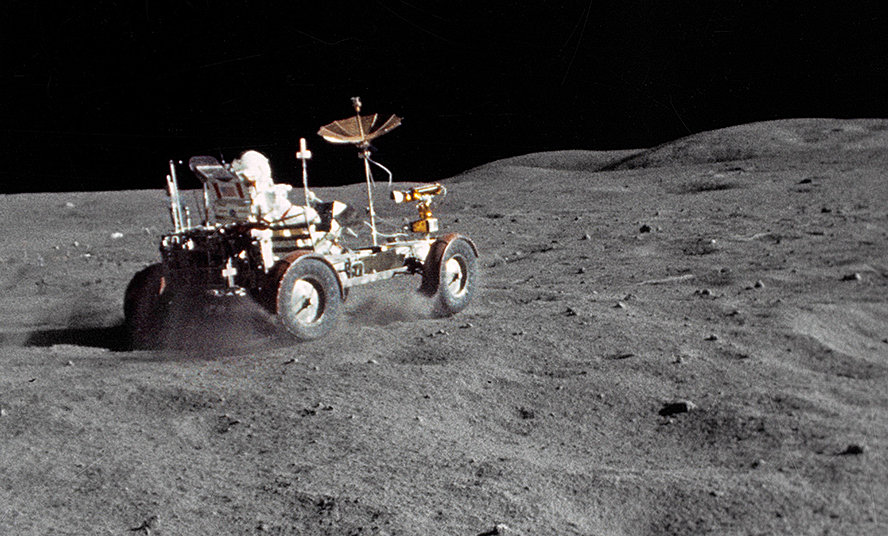
Measuring Moon Dust to Fight Air Pollution
Subheadline
NASA’s need to contain hazardous lunar dust led to technology that senses other pollutants
Moon dust isn’t like the stuff that collects on a bookshelf or on tables – it’s ubiquitous and abrasive, and it clings to everything. It’s so bad that it even broke the vacuum NASA designed to clean the Moon dust off Apollo spacesuits.
With NASA’s return to the Moon and its orbit, it will need to manage the dust, which is dangerous for people too. The first step is knowing how much is around at any given time. Efforts to do just that are already paying off on Earth, in the fight against air pollution.
Apollo missions struggled to deal with damage done by lunar dust. It clogged the camera equipment and scratched helmet visors so badly that astronauts had difficulty seeing. During the Apollo 17 mission, astronaut Harrison Schmitt described his reaction to breathing in the dust as “lunar hay fever,” experiencing sneezing, watery eyes, and a sore throat. The symptoms went away, but concern for human health is a driving force behind NASA’s extensive research into all forms of lunar soil, called regolith.
Sensitive tissues such as the lungs and corneas can be damaged by lunar dust trapped inside a habitat. While air filtration can remove a great deal of the tiny particles, an air-quality sensor is necessary to ensure the controls are effective.
This was one focus of NASA’s Next Space Technologies for Exploration Partnerships (NextSTEP) program. Through NextSTEP, the agency issued a series of documents detailing specific needs for a future lunar habitation and inviting private industry to help overcome obstacles to future lunar missions. One of these needs was for air revitalization and monitoring, including a way to measure lunar dust in surface and orbiting habitats.
Lunar Outpost Inc. was founded in Denver in 2017 with the goal of developing technologies for lunar exploration and then adapting them for use on Earth. Based on the specifications laid out in NextSTEP documents, the company developed an air-quality sensor it called the Space Canary.
Lunar Outpost offered the sensor to Lockheed Martin Space, which was one of several companies to successfully bid on a NextSTEP public-private partnership to build lunar orbit habitat prototypes for testing. Lockheed agreed, bringing Lunar Outpost on as a contributor to tweak the Space Canary to NASA’s needs.
After the device was integrated into the environmental control system, it provided distinct advantages over traditional equipment. Rebranded Canary-S (Solar), it’s now filling a need for low-cost, wireless air-quality and meteorlogical monitoring on this planet.
It Starts with Dust
Here on Earth, particulate matter is a form of air pollution generated by forest fires, volcanic eruptions, and burning fossil fuels, among other processes. The particles, a mix of liquid and solid, are tiny, much smaller than a grain of sand. This kind of pollution causes myriad health problems, including respiratory and cardiovascular problems, and contributes to numerous environmental issues, including climate change.
Off-world, particulate matter could pose similar health risks. And the mechanical systems designed to protect astronauts, such as air filtration, can be damaged by the abrasive nature of the dust.
“We are still learning about techniques to mitigate dust intrusion into the crew habitable areas and how to remove it,” said Tracy Gill, project engineer for the Mission and Commercial Support Office at NASA’s Kennedy Space Center in Florida. “Having a measurement system like Lunar Outpost demonstrated would help us understand the environment the crew is experiencing and help us to keep within the recommended exposure limits.”
The Canary and the Mine School
The Canary-S is a self-contained unit powered by solar energy and a battery that transmits data using cellular technology. It can measure a variety of pollutants, including particulate matter, carbon monoxide, methane, sulfur dioxide, and volatile organic compounds, among others. The device is constantly taking measurements and sends a message up to a secure cloud every minute, where it’s routed either to Lunar Outpost’s web-based dashboard or a customer’s database for viewing and analysis.
The sensors and software are flexible, making customization simple.
“Nowadays, everybody's so used to plug-and-play,” said Chris Cloutier, habitation design and integration lead at Kennedy, so having that flexibility is “a key capability.”
Proving the sensors’ accuracy on Earth, however, can be difficult. The device exceeded NASA requirements for the habitat prototype, but outdoor readings are trickier because they’re influenced by wind and humidity.
The Canary-S had some support with that in the form of a recent study by the Payne Institute for Public Policy of the Colorado School of Mines. The independent verification of the technology validated the accuracy of the sensor readings for both daily and long-term measurements.
Supporting Firefighters, Emissions Controls
The Canary-S is deployed in 15 states and across numerous industries. One customer is the U.S. Forest Service, which is using the Canary-S to monitor forest-fire emissions in real-time.
“Firefighters have been exhibiting symptoms of carbon monoxide poisoning for decades. They thought it was just part of the job,” explained Julian Cyrus, COO of Lunar Outpost. But the sensors revealed where and when carbon monoxide levels “were sky high,” making it possible to issue warnings to take the necessary precautions.
The same devices can measure the particulate matter in urban areas. Evidence of poor air quality can trigger alerts warning people, especially those with respiratory conditions, to take necessary precautions. The city of Denver chose the Canary sensor to collect air-quality data at local schools to educate and inform teachers, parents, and students about their local air quality. The data quantified the benefits of a no-idle campaign near schools and provided general emissions pollution in key sites around the city.
In the oil and gas industry, the sensors can help provide evidence for how effective environmental controls are, explained Charles Losche, senior manager of growth and policy for Project Canary. The company deploys Canary-S sensors to provide continuous, real-time monitoring of fugitive gas emissions.
That data can help justify the cost of those controls, said Losche, who noted that without the readings, the oil and gas producers “had no way to prove their efforts are reducing their impact on the environment.”
Additionally, sensor readings make it possible to determine if a spike in hydrocarbons such as volatile organic compounds or methane is coming from the facility or a truck driving past. If it’s a mechanical malfunction in the facility, a repair crew is dispatched.
Cyrus, who previously worked on the Orion spacecraft as an employee at Lockheed, recognized NASA as a driving force behind the company’s work to develop dual-purpose technology for use on the Moon and Earth. In addition to studying a wealth of lunar data when designing the sensor, the NextSTEP program made the opportunity to work with NASA a reality.
“Supporting the private-public partnership is going to create a sustainable presence on the Moon,” Cyrus said. “Establishing that approach is one of the most important things that NASA has done over the last few years.”
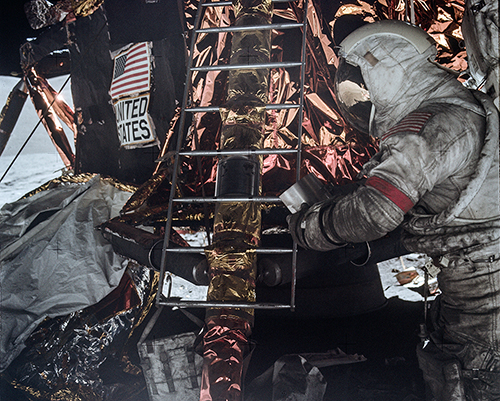
While astronaut Gene Cernan was on the lunar surface during the Apollo 17 mission, his spacesuit collected loads of lunar dust. The gray, powdery substance stuck to the fabric and entered the capsule causing eye, nose, and throat irritation dubbed “lunar hay fever.” Credit: NASA
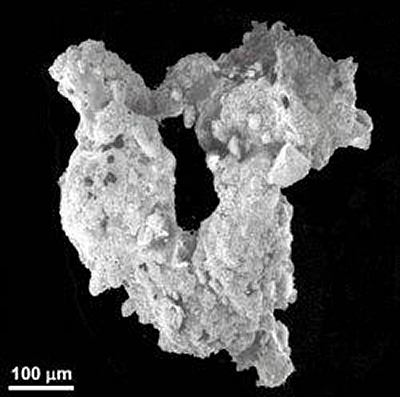
Lunar dust, the finest type of lunar soil, is similar in composition to lava rocks on Earth. It is formed when micrometeorites collide with the Moon. Enough energy is released to melt the surface rocks into a glass-like substance, which cools into tiny flecks. Credit: NASA
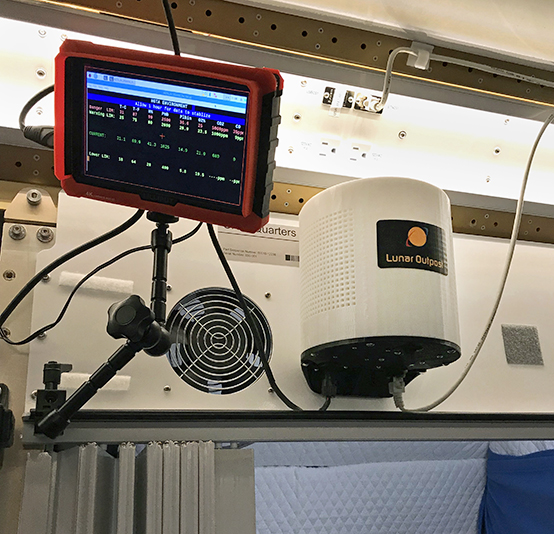
Ahead of future lunar missions, NASA wanted a sensor to act like a canary in a coal mine, warning inhabitants if the level of dust gets dangerous. Lunar Outpost Inc. developed the Space Canary, an air-quality sensor, shown here in a lunar habitat prototype designed by Lockheed Martin. Credit: Lockheed Martin Corporation
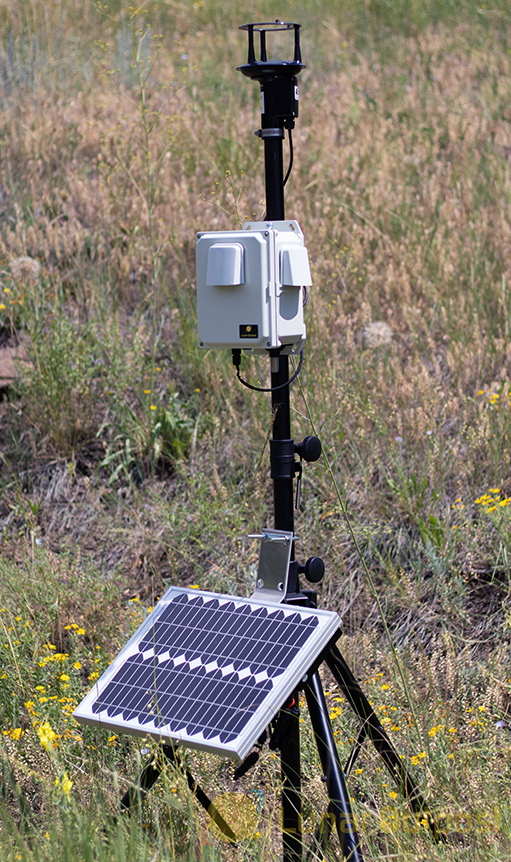
The Space Canary sensor developed by Lunar Outpost Inc. can detect the ultra-fine lunar dust particles inside a habitat, alerting astronauts should an elevated level of contamination occur. Adapted for use on Earth, the same technology, now renamed the Canary S, can monitor forest fire emissions, evaluate urban air quality, and more. Credit: Lunar Outpost

As the Apollo astronauts explored the lunar surface, they had to contend with lunar dust, which is abrasive and damaging to lungs and equipment. Credit: NASA













